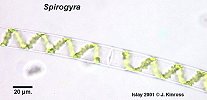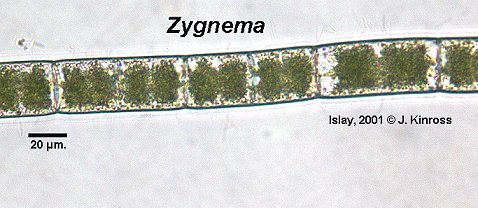FILAMENTOUS ALGAL SPECIES COMMON IN ACID AND SOFT WATERS.
Descriptions of operational taxa found in field studies in Scotland.
(Loch
Ard area of The Trossachs, Galloway, Islay, Morar and Glenelg:
Kinross, 1985, 1991 and unpublished data)
LIST
Zygnemataceae: Zygnemales:
Spirogyra
Zygnema
Mougeotia
Taxon no. (1-50 as referred to in Kinross et al, 1993)
Zygnemataceae: Zygnemales
These have been found entangled with other vegetation rather than actually attached to the substratum and have not been observed in culture. The cells are cylindrical, the filaments long, uniform in diameter and with clearly visible spiral band chloroplasts.
Two size classes were found in L. Ard samples;
25 = diameter approximately 20Ám
26 = diameter approximately 32Ám.
other taxa subsequently found in other areas are:
54 = dia. 11Ám.
56 = dia. 70Ám.
27, 28 = Zygnema species
These are usually distinctive, being broad (approximately 20Ám or 28Ám diameter respectively) filaments, with twin stellate chloroplasts, dark green under the microscope but the mass of filaments appearing almost brown to the naked eye.
Cell diameter is reported to be an unreliable taxonomic feature in this genus (Miller and Hoshaw, 1974).
A morphological variant was rarely encountered in samples from Loch Ard and other areas, in which the chloroplast is a parietal ribbon or band, the full length of the cell, but filling approximately 50% of the circumference so that it appears similar to Mougeotia or Ulothrix spp. That it was actuallyZygnema was revealed when a filament was discovered which had normal Zygnema morphology at one end but the aberrant form at the other. There were no pyrenoids visible in the aberrant chloroplast.
29-33 = Mougeotia species
Mougeotia species have an axial band chloroplast with several pyrenoids. The criterion for species identification rests on the morphology of the zygospore so that it is not possible to determine the species of most field specimens. The filaments are essentially unbranched but occasional short branches can be found in taxa 30-33, originating at a Y-shaped cell. The lateral outgrowth may have a somewhat irregular appearance and sometimes appears to be functioning as an additional holdfast cell. In culture Mougeotia species were not observed to develop from spores but from hormogonia. One end of the filament appeared to develop the ability to attach to the substratum, and in the case of the narrowest cell type, (5-)8Ám diameter, the basal cell was almost always found to form a recurved hook-like structure. Larger taxa attach by means of a cell with irregular outline as described above.
The operational taxa are:
29 = 5-8Ám.
possibly M. viridis (Kutz.) Wittr. (may include other species also)
The chloroplast is usually of a very clear rather than granular appearance,
unlike most other Mougeotia taxa. 
30 = 11Ám,
with a granular chloroplast. 
31 = 14-17Ám.
possibly M. capucina (Bory) Agardh.

57 = 11Ám., with a clear chloroplast.
Taxon 31 frequently has cytoplasm tinged purple, indicating M. capucina. The identifications are after Randhawa (1959).
Back to images sorted by Genus Back to Algae in Acidified Streams
John Kinross






